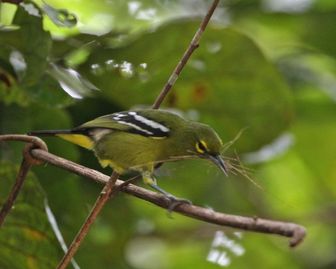Green Iora
Its natural habitats are subtropical or tropical moist lowland forests and subtropical or tropical mangrove forests. It is threatened by habitat loss.

Original source: Lip Kee YapPermission(Reusing this file)This image, which was originally posted to Flickr.com, was uploaded to Commons using Flickr upload bot on 13:24, 1 January 2009 (UTC) by Aroche (talk). On that date it was licensed under the license below. This file is licensed under the Creative Commons Attribution-Share Alike 2.0 Generic license.You are free:to share – to copy, distribute and transmit the work
Author: Lip Kee YapPermission(Reusing this file)This image, which was originally posted to Flickr.com, was uploaded to Commons using Flickr upload bot on 13:24, 1 January 2009 (UTC) by Aroche (talk). On that date it was licensed under the license below. This file is licensed under the Creative Commons Attribution-Share Alike 2.0 Generic license.You are free:to share – to copy, distribute and transmit the work
The Green Iora is classified as Near Threatened (NT), is close to qualifying for or is likely to qualify for a threatened category in the near future.
“According to the Red Data, the Green Iora is Near Threatened, bordering on Vulnerable locally (not internationally). The species is a mainly recorded as feeding on invertebrates / insects (Wells 2007) and my observations confirm this. I have personally documented the bird feeding on flying insects and caterpillars, never fruit. “However, on 21st October 2009 at the Kledang-Sayong Forest Reserve in the Malaysian state of Perak, I had an unexpected encounter with the iora, an adult female, feeding on the fruit of Macaranga bancana. More
activities, although the Green Iora is listed as near threatened by the IUCN, habitat loss is responsible for its decline. Unlike many other passerines they are not common species in the cage bird trade. More
* A female Green Iora A female green iora perching on a tree Southern Thailand, Thailand Tanakorn 29 August 2009 36 weeks ago 3.8 * Green Iora A male perching on a tree Ton Nga Chang Wildlife Sanctuary, Southern Thailand, Thailand Tanakorn 31 August 2009 36 weeks ago 3 Sounds 2 recordings * Song. More
A female green iora perching on a tree Southern Thailand, Thailand 29 August 2009 31 August 2009 3. More
The Green Ioras are the less commonly seen species of Ioras in Kemensah. Restless and hyperactive most of the time remaining between the leaves, they are difficult to shoot. This is a male. _DSC0094_f _DSC0118_f Posted by madibirder at 12:07 AM Labels: Iora, Kemensah 1 comments: Tabib said... So low in that senduduk tree. More
Results for: Green IoraTranslations 1 - 1 of 1 English English Norwegian Norwegian green grønn, grøntareale Search time: 0.004 sec. About EUdict - EUdict (European dictionary) is a collection of online dictionaries for the languages spoken in the European Community and the countries that will become members of European Community. More
Results for: green ioraTranslations 1 - 30 of 217 English English Finnish Finnish green iora viherjora, Aegithina viridissima marshall’s iora intianjora, Aegithina nigrolutea common iora jora, Aegithina tiphia great iora isojora, Aegithina lafresnayei to green vihreäksi green for go vihreävalo be green vihannoida, viheriöidä, More
Embed this Topic The Green Iora (Aegithina viridissima) is a species of bird in the Aegithinidae family. It is found in Brunei, Indonesia, Malaysia, Myanmar, Singapore, and Thailand. Its natural habitats are subtropical or tropical moist lowland forests and subtropical or tropical mangrove forests. It is threatened by habitat loss. The Green Iora (Aegithina viridissima) is a species of bird in the Aegithinidae family. It is found in Brunei, Indonesia, Malaysia, Myanmar, Singapore, and Thailand. More
The green iora (Aegithina viridissima) and the lesser green leafbird (Chloropsis cyanopogon) have nearly identical ranges, in Thailand to the Malay Peninsula, Sumatra, and Borneo. They are listed as Near Threatened, as is the blue-masked leafbird (C. venusta), a Sumatran endemic. The Philippine leafbird (C. flavipennis) is Vulnerable. In addition to being restricted to threatened habitats, it has always been considered uncommon, in contrast to the other three IUCN listed species, which are considered locally common in parts of their range. More
Family : Aegithinidae
Genus : Aegithina
Species : viridissima
Authority : (Bonaparte, 1850)

